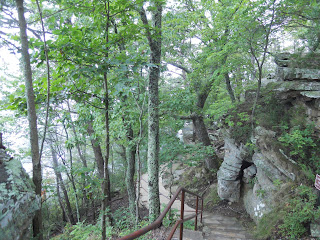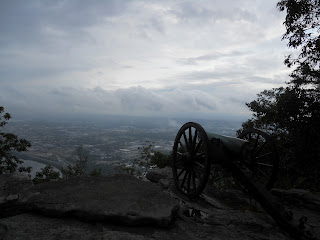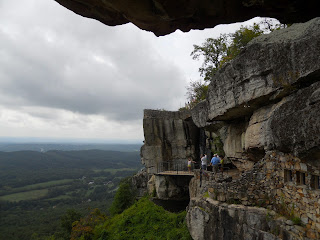We were, as it
turns out, only about fifteen minutes away from the Lookout Mountain
section of the Chattanooga and Chickamauga National Military Park, so
we visited that first. The views were absolutely stunning, and though
the Chattanooga campaign was a bit difficult to follow, the Lookout
Mountain portion was fairly straightforward. The visitors' center had
the original large-format painting commissioned by General Joseph
Hooker to celebrate his victory at Lookout Mountain in the “Battle
Above the Clouds,” and had good interpretation of the same.
Its exhibits were
crisp and new and well-done, alternating explanatory text with
interesting facts (Rosecrans and Longstreet were roommates at West
Point!), and never overwhelming with too much text.
Point Park itself,
where the Confederate guns were placed, was stunning. The views over
Chattanooga and Tennessee were breathtaking. There was also a neat
little exhibit case with Civil War signal corps artifacts and
explanatory text – the first time we've seen anything on that part
of the army.
 |
| Confederate gun emplacement overlooking Chattanooga. |
 |
| Twisting trails around Point Park. |
 |
| Seriously, wow. |
After Lookout
Mountain, we realized we were only a few miles from Rock City, one of
the great tourist traps in North America and the location of the
climax of Neil Gaiman's novel American Gods. We decided to
take a detour, and it was – an experience. Tacky alternated with
genuinely lovely. Gaiman's thesis in his novel is that the old world
gods came to America with immigrants, and that the holiest places in
America are roadside attractions, because they collect that which is
uniquely American – a kind of entrepreneurial
something-out-of-nothing pop-culture blend. Rock City is certainly
the perfect place for all of that to come together.
 |
| Lover's Leap at Rock City |
Next up was the
Chickamauga battlefield, the major battle that led up to the siege of
Chattanooga. The Confederates won this battle, but ultimately lost
the campaign when they failed to successfully siege the Union army at
Chattanooga. The battle itself was characterized mostly by staggering
failures of communication among the general staff of both sides.
Braxton Bragg wrote vague orders and his troops did not attack in
time; William Rosecrans pulled a regiment from his right flank to
shore up a perceived hole in his left flank. There was no hole, and
the removal of a regiment left an actual hole in his right flank at
the exact moment James Longstreet arrived to reinforce the
Confederate left and made an offensive.
The Union lines
crumpled and fled, all except a few brigades under George Thomas's
XIIth Corps, who held Snodgrass Hill thanks to determination and to a
particular brigade equipped with Spencer repeating rifles, giving
Thomas the nickname “The Rock of Chickamauga.” His delaying
action allowed Rosecrans and the Army of the Cumberland to retreat
safely to Chattanooga. Once the Confederates failed to siege the
city, it proved the perfect base of operations for Sherman to march
south to Atlanta the following spring.
 |
| The slight rise to the left of the photo is where Thomas and his brigades held during the retreat. |
The Chickamauga
visitors center might have been the nicest we've seen so far. It had
a beautiful, welcoming lobby with a big relief map of the
battlefield, and some neat exhibits that made good use of artifacts
to create scenes. Unfortunately, its orientation video was the worst
I have ever seen. I was physically cringing through much of it. It
began with a fairly standard framing voiceover leading up to the
battle, but the segued into an odd first-person narrative in which
two actors playing reminiscing Union and Confederate soldiers (though
still wearing their uniforms during what was supposed to be a meeting
years after the fact?) chatted about the battle with an odd mix of
supposedly personal information and strategic overview. The editing
was clumsy at best, and the jaunty way the narrators used slang and
referred to actions meant that at the end of 23 minutes I had not the
slightest idea what had happened in the battle, and was utterly
shocked to hear that the casualties had been so high – in the tens
of thousands. It was distasteful and confusing – and as the cherry
on top, the Union soldier (or the actor playing him) had a thick
Southern accent.
 |
| Beautiful, informative entrance hall. |
 |
| Still from the video; faked Union and Confederate soldiers to the left. |
Luckily, there was
an old-style electric map in another exhibit that we, along with a
dozen other visitors, crowded around in order to understand the order
of battle. The driving tour was quick but good, and actually had a
nice balance of length and stops. Shiloh had 20 stops, which was
wearing; Chickamauga had only 8, but all were important and
interesting.
From Chickamauga,
we followed in Sherman's footsteps south to Atlanta, then skirted the
city to arrive at Stone Mountain, the largest granite outcropping of
its kind in the world. Stone Mountain functions as a sort of
Confederate shrine: carved onto the mountain is a bas-relief of
Jefferson Davis, Robert E. Lee, and Stonewall Jackson. The gardens
leading up to the mountain feature small terraces dedicated to each
of the Confederate states. (On Mississippi's terrace, the placard
noted that among its famous leaders was Jefferson Davis, President of
the Confederacy, who “served ably under extremely difficult times.”
You don't say.)
 |
| Stone Mountain |
At the base of the
garden were two parks, one dedicated to Valor and the other to
Sacrifice, featuring more apologia and some marvelous cognitive
dissonance.
 |
| "Valor" park. |
Many of the sites
we've been to have had to handle the difficulty of being in the South
while also telling an accurate, whole picture of the war. Stone
Mountain was not a museum, nor even a cultural site; it functions
today mostly as a family adventure center, with a ropes course and
other children's activities. It was definitely the most Southern
point of view we've seen so far, and given tomorrow we're turning
north for good – it will most likely retain that honor.